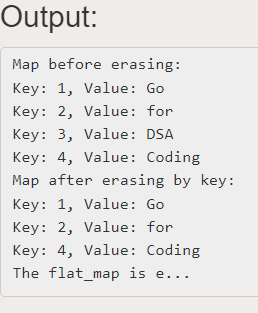C++ flat_map
In this article, you will learn about the flat_map in C++ with its example.
A flat map: what is it?
A data structure called a flat_map combines the characteristics of a vector and a map. In essence, it is an ordered associative container that stores key-value pairs in a contiguous memory architecture, much like a vector.
There are several significant implications for this design choice's use:
1. Ordered items:
- The items in a flat map are kept in a certain order determined by the key, in contrast to std::unordered_map, which has no particular order.
- It is helpful in situations where element order must be maintained.
2. Quick Lookup:
- A flat map, like std::map, enables quick lookups depending on the keys.
- Because the keys are maintained in order, search operations can be performed with logarithmic time complexity.
3. Vector-Like Features:
- Like a vector, a flat map lets you traverse through the elements quickly because the data is stored consecutively.
4. Low Memory Overhead:
- As a flat map stores its items in a contiguous manner, it generally has less memory overhead than a std::map.
5. Value Semantics:
- A flat_map stores key-value pairs together, as opposed to std::map, which stores keys and values independently.
- This makes using the data structure easier.
What distinguishes it from other implementations of maps?
It's important to contrast a flat_map with other C++ map implementations to fully appreciate its benefits:
1. std::map
- A balanced binary search tree-based container is std::map.
- It provides logarithmic complexity and keeps the elements sorted for the majority of operations.
- However, because of the tree structure, there is some overhead, which could lead to a slightly greater memory consumption.
2. std::Unordered map
- Because std::unordered_map is built on a hash table, most operations have constant-time complexity.
- However, it does not preserve a particular sequence for the elements.
- While it uses less memory than std::map, it isn't the best option when element order is important.
3. flat map
- The advantages of both worlds are combined in a flat_map, which provides vector-like iteration, quick lookups, ordered items, and little memory overhead.
- It is a desirable option for many use scenarios due to its ordered elements and contiguous storage, particularly when you require both efficient key-based access and a predictable element order.
When to Use flat_map:-
There are several situations where you can use the flat_map. In the following situations, a flat_map might be a wise option:
1. Maintaining Element Order:
- A flat map is a great option if you need to preserve a particular element order.
- For jobs like sorting and showing data, it can be helpful.
2. Key-Based Lookup:
- A flat_map is a suitable choice if you need a quick key-based lookup with logarithmic complexity.
- In terms of efficiency, it finds a middle ground between std::map and std::unordered_map.
3. Iterating Efficiently:
- A flat map offers contiguous storage, which makes it the best option when you need to iterate across elements as if you were using a vector.
4. Low Memory Overhead:
- Because a flat_map's storage is contiguous, it usually has less memory overhead than a std::map when memory use is an issue.
Program:
Let's take an example to illustrate the use of flat_map in C++.
Output:

Explanation:
- Include Headers: The required C++ standard library headers are included at the start of the code. It comprises <map> to build a map, <vector> to create a vector, and <iostream> for input and output.
- Make a std::vector and std::map: We define two types of data structures: two objects: a std::vector of std::pair<int, std::string> named flatMap and a std::map named myMap. The vector will mimic a flat map, and the map will hold key-value pairs.
- Insert Key-Value Pairs into the std::map: The myMap is updated with four key-value pairs using square bracket notation. Strings are the values, and integers are the keys.
- Convert std::map to a Flat Map (Vector): Using the push_back method, the code iterates through the myMap adding each key-value pair to the flatMap vector. It mimics how a std::map is changed into a flat map that is represented by a std::vector.
- Print the Map Before Erasing: The code outputs the key-value pairs from the flatMap vector before any erasing takes place. The vector is iterated through, showing each key and value.
- Clear the Flat Map (Vector): The code utilises the clear method to delete all entries from the flatMap vector to effectively clear the flat map.
- Check whether the Flat Map is Empty: Lastly, the code uses the empty method to see if the flatMap vector is empty. If it's empty, a notification saying that the cleared flat map is empty is shown.
Conclusion:
Among C++ data structures, the flat_map is a particularly adaptable and effective option for a range of use situations. It combines the minimal memory overhead and vector-like iteration of std::unordered_map with the ordered items and key-based lookup of std::map.
|

 For Videos Join Our Youtube Channel: Join Now
For Videos Join Our Youtube Channel: Join Now










